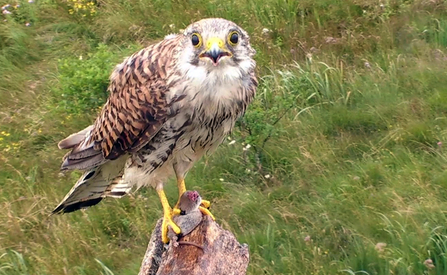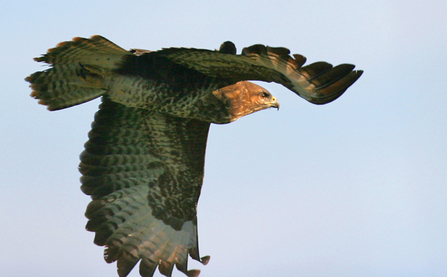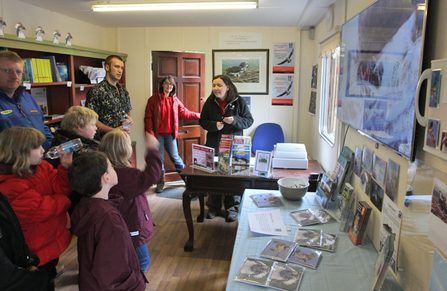Last Saturday evening, May 25th, at 19:06, Glesni laid her second and last egg for the season. She laid it 3 days and 1¾ hours after her first egg.
So here is the completed video showing the build up to Glesni laying both her eggs..
Last Saturday evening, May 25th, at 19:06, Glesni laid her second and last egg for the season. She laid it 3 days and 1¾ hours after her first egg.
So here is the completed video showing the build up to Glesni laying both her eggs..
© MWT
The incubation period for osprey eggs is around 37 days, so all being well, we should expect the first chick to hatch at around June 28th time. We are currently on DAY 11 of our 24-hour protection shifts. A lot more matchsticks required for the next four weeks then!
~~~~~~~
On Wednesday, as I was walking through Machynlleth looking for a bird feeder for the project, I bumped into a friend of mine. I don't see him often, but every time we do meet it's never for long enough. He was busy working for the Springwatch team down the road and I was busy trying to sort out all the rotas and volunteers for the 24-hour egg watch shifts for the osprey protection.
We did talk briefly, however, about a report that has just been published. For the first time ever in this country, dozens of wildlife organisations have been working together to amass a definitive stock-take on where we are right now in terms of wildlife and whether species are recovering, stable, or declining. It makes for grim reading; 60% of all species studied are declining and one in 10 are under threat of extinction in the UK.
On Friday I was talking to another friend of mine that also occasionally works for the BBC - as a cameraman. We were discussing the brilliant images that the Springwatch team had taken of a buzzard's nest on this week's shows. A bird of prey that I simply did not see as a child growing up in north Wales, but are now thankfully recovering after centuries of decline.
A buzzard takes a fancy to Monty's nest last year before he returned from Africa

Buzzard. © MWT
Unlike just a few decades ago, we now have laws in place to protect birds like the buzzard and other raptors, laws that are presided over and upheld by government organisations like DEFRA - The Department for Environment, Food and Rural Affairs. Great news then. We also have other tax-funded government organisations that uphold these laws - in England this organisation is called Natural England.
This is what Natural England do, taken from their own website:
"Natural England is the government’s advisor on the natural environment. We provide practical advice, grounded in science, on how best to safeguard England’s natural wealth for the benefit of everyone.
Our remit is to ensure sustainable stewardship of the land and sea so that people and nature can thrive. It is our responsibility to see that England’s rich natural environment can adapt and survive intact for future generations to enjoy."
Excellent - so we are in good hands, and our children.
Kestrels have been on a rapid decline over the last few years. Kestrels, like all birds of prey, are indicators of a healthy ecosystem.

Kestrel. © MWT
Here comes the crazy bit then; you may have to read the next paragraph twice, as you may become under the illusion that you have misread it the first time.
"The UK’s nature conservation agency, Natural England, has licensed the secret destruction of buzzard eggs and nests to protect a pheasant shoot.
This destruction, which took place in the last few weeks, was only revealed after a Freedom of Information request was made by the RSPB. According to the article, the National Gamekeepers Organisation was ‘closely involved in winning the licences and had threatened Natural England with judicial review if they were not granted’."
So let's get this right. A persecuted British native bird of prey, which is finally after many years making a recovery, is being eliminated so that a few rich people - the 1% of the 1% that live in this country, can go and shoot pheasants, an Asian introduced bird, for 'sport'? Yep, generally rich men blasting birds (that can barely fly anyway - it's next to impossible to miss) out of the sky, and taking with them, indirectly, the buzzard.
Not that it needs it, but the science does not even hold up. The average level of predation of game birds by raptors in the UK is only 1-2%, and that's by all raptors, not just buzzards. And this is data gathered by the British Association for Shooting and Conservation!
A stunning buzzard soaring over Cors Dyfi Reserve

Buzzard. © MWT
So why are these government organisations, funded by you and me via the tax we pay, issuing licences to destroy the very birds they are supposed to protect? Maybe we should ask the MP for wildlife and the Environment, Richard Benyon? After all, it's Mr. Benyon who is the Parliamentary Under-Secretary of State for DEFRA and Natural England. With the winds of public concerns blowing strongly in his face just 12 months ago regarding destroying buzzards, Mr Benyon promised "I will collaborate with all the organisations that have an interest in this issue and will bring forward new proposals". So much for that promise then.
Just a few months ago, Mr Benyon refused a request from fellow MPs that possession of carbofuran, a deadly poison used to kill birds of prey that is banned in the European Union, should be made a criminal offence in the UK too. But why? Is he asleep on the job? Surely, this is not a case of a conflict of interest is it?
According to his Wikipedia page, Mr Benyon is the richest of all the MPs at Westminster and has a personal wealth of over £100,000 000 (one hundred million!). The Minister responsible for all of the wildlife in the UK, Mr Benyon, is a multi-millionaire landowner who is strongly associated with shooting interests and owns both a pheasant shoot in Berkshire and a Scottish grouse moor. Now you really couldn't make this up could you. Another cherry brandy anyone?
I go back to my conversation with my friend in the centre of Machynlleth the other day. This is what he had to say last week about the State of Nature report that has just come out, and the likes of Mr Benyon MP..
Iolo is right, it's not too late. Nature still has a voice - you and me. People have devoted lifetimes to bringing species back from the brink in this county - think of ospreys and red kites as great avian examples. But you don't need a lifetime or even a degree in conservation to make a difference in 2013, we can all be conservationists.
You can even help just by sitting at home. Facebook, Twitter, YouTube and a host of other online media have made information more accessible that it ever has been in the past. You can make yourself heard, sign petitions, write to Natural England, DERFA and even the MP responsible for "Wildlife" - and you don't even need a stamp these days.
We can all make a difference because we all have a voice. Buzzards, ospreys, and countless other species in need of protection in the UK can't speak for themselves, we have to speak for the 60% of them that are declining. Montgomeryshire Wildlife Trust is one of 46 Wildlife Trusts around the UK that has a soapbox, a voice and a stance on protecting wildlife. Join your local Wildlife Trust - I guarantee you can join just for the price of a pint of beer a month. Mr Benyon, if you're reading this, here are the details of how to join your own local Berks, Bucks & Oxon Wildlife Trust. Maybe you could spare a day or two a month and volunteer for them?
And finally an image. This is Janine, our People Engagement Officer, at the Dyfi Osprey Project last weekend answering some children's questions about the first egg that Glesni has just laid. Her first ever. The kids are looking at the screen and are enthralled that they can see an osprey in Wales laying an egg - something that has not happened here for many centuries until the last decade. They have questions, comments, and a huge appetite and enthusiasm to learn.
Starting on the Dyfi Osprey Project's Facebook page tomorrow (you don't need to be registered, you can still view), we are starting a new feature running for a week: "Seven Things You Never Knew About Ospreys.." It's aimed at learning, children, and understanding more about a much persecuted bird of prey. It's about protecting and conserving wildlife, not destroying it. We owe it to these children to look after the ospreys, they will still be here in 50 years and we have to make sure that the ospreys will be too. We are compelled to leave them a legacy of an environment that is clean and rich in diversity for everyone, not one that is poor and just for the rich.
We have to take a stand against these wildlife injustices. Make your voice count, please.
Diolch Iolo.

© MWT